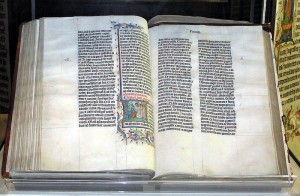 When he was the Archbishop of Washington, Cardinal James Hickey told a funny story of an experience he had at Reagan National Airport, while on his way to Rome. Even though he was 75 years old and obviously dressed as a bishop, he was told by an embarrassed ticket agent that he had “fit the profile” of an international terrorist, mostly because he held a one-way ticket. As a result, he had to submit to a complete search. Although he was able to laugh about it later, at the time Cardinal Hickey was, shall we say, not amused.
When he was the Archbishop of Washington, Cardinal James Hickey told a funny story of an experience he had at Reagan National Airport, while on his way to Rome. Even though he was 75 years old and obviously dressed as a bishop, he was told by an embarrassed ticket agent that he had “fit the profile” of an international terrorist, mostly because he held a one-way ticket. As a result, he had to submit to a complete search. Although he was able to laugh about it later, at the time Cardinal Hickey was, shall we say, not amused.
This story just goes to show that none of us wants to be falsely identified or misunderstood. Jesus himself was very concerned about being properly understood, as we heard in today’s gospel. When he asked his friends about who people thought he was, he received a variety of answers: John the Baptist, Elijah, Jeremiah, maybe one of the other old prophets come back to life. Yet each of these answers, while not bad in light of the circumstances, was wrong. It was up to Peter who, prompted by the Holy Spirit, proclaimed Jesus to be the Messiah, the Son of the living God.
Jesus wishes to be properly understood, not for his sake, but for ours. This is because our understanding of who Jesus is has profound implications for our behavior. As Christians, we seek to live in imitation of Christ. It follows, then, that the image we have of Christ will largely dictate how we shape our lives in order to conform to his. If we operate with a distorted image of Jesus, we will end up living distorted lives.
All of us here today share common beliefs about Jesus. When we recite the Creed together, we say, “We believe in one Lord, Jesus Christ, the only Son of God, eternally begotten of the Father,” and so forth. Nevertheless, we can profess correct doctrine in Jesus and still operate with a warped image of who he is. Just consider Peter in today’s gospel. He correctly identified Jesus as the Messiah. But then, moments later, as we’ll hear in next week’s gospel, he was appalled to learn that Jesus would be tortured and executed. His image of Jesus, at that time, did not include the possibility of his suffering and death.
Like Peter, most of us operate with a limited understanding of who Jesus is. Which is understandable; as today’s second reading reminded us, the things of God are largely a mystery to us! I have a suspicion that when we meet the Lord face-to-face at the end of our lives, we will be absolutely astonished by the full reality of who he is. In the meantime, however, our image of Jesus needs to be constantly revisited, challenged, and revised.
 To do this, it’s important to recall where our images of Jesus have come from. For instance, our culture shapes our image. I once read how Victorian England was scandalized by a painting, called “The Carpenter’s Shop,” that depicted Jesus and the rest of the Holy Family in Joseph’s workplace. They were portrayed as rustic, simple, and poor- just as Scripture and historians tell us they were. Yet the class-conscious Victorian English refused to accept Jesus as portrayed in such a way. Their culture had a warped understanding of Jesus. You and I need to be on guard for how our materialistic, faced-paced, self-centered, and superficial culture might disfigure our image of our Lord.
To do this, it’s important to recall where our images of Jesus have come from. For instance, our culture shapes our image. I once read how Victorian England was scandalized by a painting, called “The Carpenter’s Shop,” that depicted Jesus and the rest of the Holy Family in Joseph’s workplace. They were portrayed as rustic, simple, and poor- just as Scripture and historians tell us they were. Yet the class-conscious Victorian English refused to accept Jesus as portrayed in such a way. Their culture had a warped understanding of Jesus. You and I need to be on guard for how our materialistic, faced-paced, self-centered, and superficial culture might disfigure our image of our Lord.
In addition, our parents play a significant role in shaping our image of Jesus. Their attitudes, prejudices, ways of handling stress, work-habits, intelligence, and temperament all contribute. Distant parents suggest a distant Jesus; angry parents evoke an angry Jesus; happy parents reflect a joyful Jesus, and so forth. Conscious of this, we need to honestly reflect on our experience with our parents and consider how this may have influenced our understanding of Jesus.
Sometimes our image of Jesus is simply a projection of ourselves. This might result in a Jesus who never challenges us and smiles upon everything we do. It might also result in a Jesus who too much reflects our anger and incapacity to forgive each other. This Jesus is quick to punish and slow to pardon, is easy to fear but hard to love. Once an adult daughter asked her mother to forgive some old hurts. Both of them are committed, practicing Catholics. Yet when the mother hesitated to forgive, the daughter asked, “Don’t you think if I told Jesus I was sorry, he’d forgive me?” But the mother said, “I don’t presume to say what Jesus would or would not do.” Sadly, her image of Jesus had been warped by her pain and resentment.
To grow in an authentic understanding of Jesus, we can do several things. First of all, we need to explore the Scriptures, especially the gospels, which paint for us complimentary and complex portraits of the Lord. “Ignorance of the Scriptures,” insisted St. Jerome, “is ignorance of Christ.” We also need to pray- honestly, openly, and frequently- and let the Spirit of Jesus deepen our relationship, and thus deepen our understanding. We need to be active in the Church, the body of Christ, where our brothers and sisters in Christ can help shape our image of Christ. We need to embrace the teachings of the Church, which come with authority and the guidance of the Holy Spirit. And we need to try and understand our pain and suffering in light of the Jesus’ cross.
First and foremost, however, you and I need to love. To truly understand Jesus, the one who came not to be served but to serve, who gave up his life that ours might be saved, we need to be generous, sacrificial, and loving people as well. Imitation may be the sincerest form of flattery. But when it comes to Jesus, imitation is the key to understanding who he truly is. To love him is to know him, and to know him is to love him.
Readings for today’s Mass: http://www.usccb.org/bible/readings/082111.cfm
Image Credits: Wikipedia Commons

Thank you, Fr. Hurd, for an important and thought-provoking reflection. The mother-daughter scenerio reminded me that based on my experience, I had a very hard time relating to Mary as a gentle and loving person — and Jesus as a person of mercy . As you indicated, the way to my understanding was through prayer, the liturgy, Scripture, the Church, and my brothers and sisters in Christ. And deep reflection on the cross in terms of pain and suffering.
Wow, that poor Bishop at the airport fit the profile of an International Terrorist simply because he has a one-way ticket? I wonder how many other passengers have one-way tickets and are stopped. Sounds like pure discrimination in that case (probably because he was wearing long religious robes). The US airports need to profile like they do in Israel. They have a very good rate at catching the bad guys by profiling and letting those who don’t appear to be the “enemy” pass through the gates. So shameful.
Sherry- Thanks, and God bless you. I’m glad that you now have a portrait of our Lord and his mother.
Kaylan- This happenned in 2002, I think, not long after 9/11. I think that because he held a one way ticket was the “trigger.”